American Drought 2012
"The corn is as high as an elephants eye" ... not in 2012, as a record drought takes its toll.
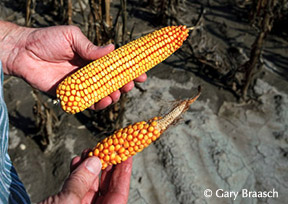
The great American drought of 2012 was the most intense in NOAA weather records and the most extensive since the 1950's. World View of Global Warming witnessed its effects across Iowa, NW Missouri, Nebraska and Kansas. During late summer when field corn for animal feed should be high and dark green, heavy with the large uniform ears of corn for which the region is famous, we saw instead vast landscapes colored brown, yellow and light green. Soybean fields were also baked and dried out. Farmers complained of lack of any rain after May, or too little rain and too late for the corn kernels to develop well, not to mention record heat. The quality of the crop varied so much even within single fields that farmers couldn't guess what the yield would be. The U. S Department of Agriculture expected food prices to go up in 2014 and beyond as the effects of a lower feed grain harvest make their way through the animal food chain. .
A NOAA task force said the drought was "the most severe since official measurements began in 1895, eclipsing the driest summers of 1934 and 1936 that occurred during the height of the Dust Bowl. "The drought developed "suddenly," said the report by 19 atmospheric scientists, and was not predicted by earlier forecasts of rainfall and heat. But in a controversial part of the study, NOAA experts said the 2012 drought "may not have had extreme [climate] forcing as its cause" and was more due to an unusual and extreme change in the jet stream. Other meteorologists did not agree and pointed out that soil moisture conditions, snow cover, and snow pack during the winter prior to the event were low because of climate change effects, and should have been recognized as important factors by the NOAA study.
Most corn across the central midwest is not irrigated, and Victor, Iowa, farmer Allan Willett said they were used to regular rains. "There's been no drought here since '88" he said. "We'll be lucky to break even," said another farmer in Adair, Iowa -- where hundreds of wind turbines spun above the dry cornfields which were being harvested up to two months early to claim some value from the corn and/or chopped up stalks for animal feed. The yearly rent from the turbines of about $5700 each is giving many farmers a new income to offset crop losses, and of course many have federal crop insurance. Viewing a desiccated field near Victor, Iowa, one landowner said it might only produce half the income it's worth, but "it don't matter to me, though. That's what insurance is for." Rogers Strickland, a farmer in Weston, Missouri, in the hard-hit NW corner of that state, lost a third of his corn crop on his thousand acres. As the drought progressed there was a wide range of effects, and Strickland estimated yields "could be 160 [bushels/acre] or could be zero." He said fields planted only a few days late suffered much more than earlier fields in which the corn had a bit more time to develop before the drought and heat struck. Corn planted on sandier soils also shriveled up rapidly. Strickland's soybeans also suffered and only produced 60 to 70 percent of normal.
Yields can range from 160 bushels/acre (bu/ac) up to above 200 in very good years on the best soil, and the national average yield was about 146 bu/ac in 2011. The Department of Agriculture Weekly Weather and Crop Bulletin reported that even though four percent more corn acreage was planted this year, total production will be 13 percent lower and the average yield 24 bu/ac lower than last year. The yield will be the lowest since 1995. How this will affect corn and food prices is still being analyzed. Most of the corn planted is usually harvested in the fall when natural drying is complete, and goes to cattle feed, ethanol or corn products markets. Farming practices, crop choices and food availability are affected by climate change -- at the same time our agricultural system is a major source of global warming emissions. For one analysis, please see Mark Hertsgaard's article in the NY Times. For more on the drought, see here and here
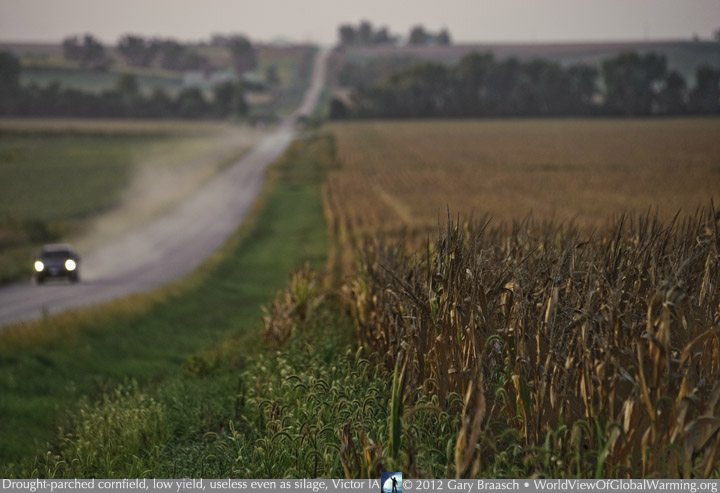
Desiccated cornfield near Victor, Iowa, which owner said was too dry even to be cut for animal feed and might yield only half the normal value in corn.
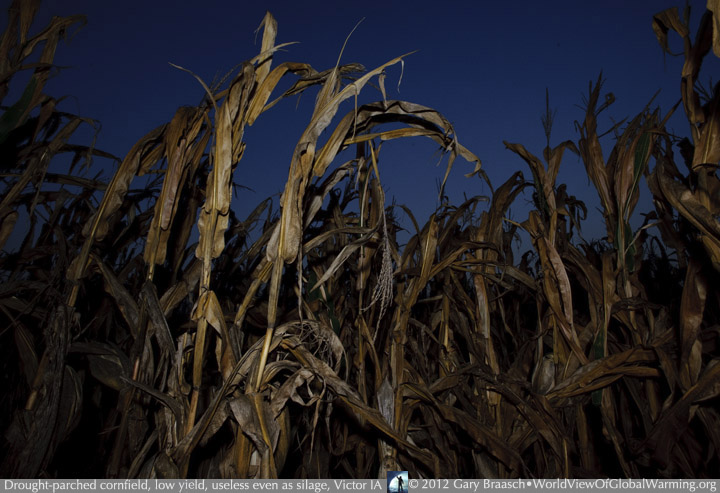
Desiccated cornfield near Victor, Iowa, which owner said was too dry even to be cut for animal feed and might yield only half the normal value in corn.
.
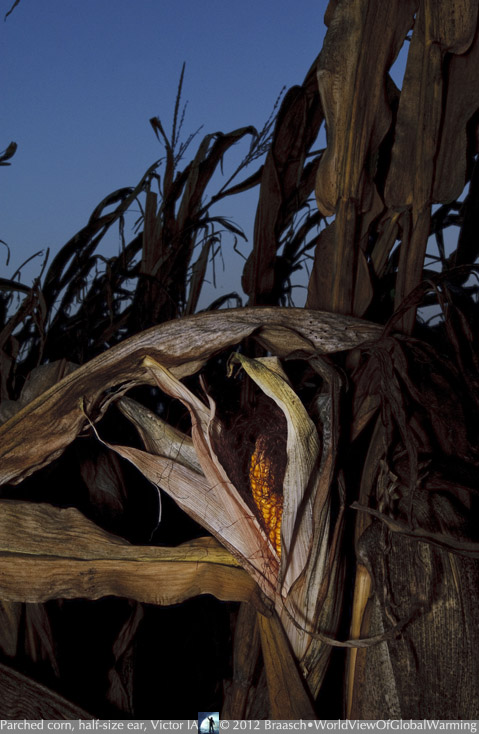
Desiccated cornfield near Victor, Iowa, which owner said was too dry even to be cut for animal feed and might yield only half the normal value in corn.
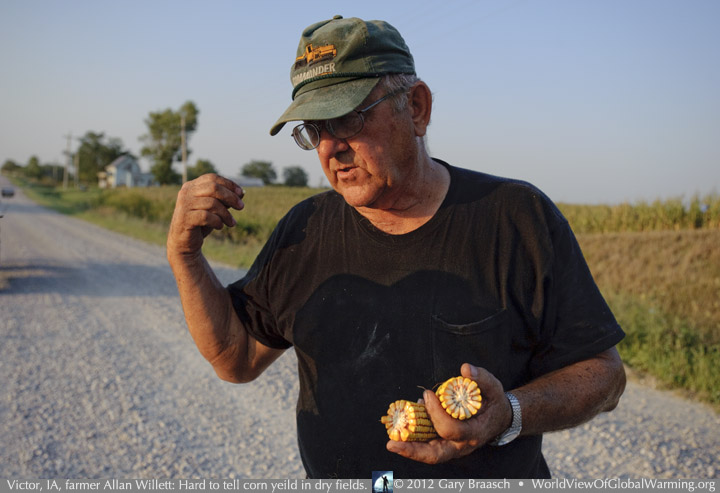
Farmer Allan Willett near Victor, Iowa, shows some fair ears of corn from a field which suffered from heat, drought and a windstorm. A new concern is growth of mold on the corn, creating poisonous and cacinogenic aflatoxin, because of warmer nights during the drought.
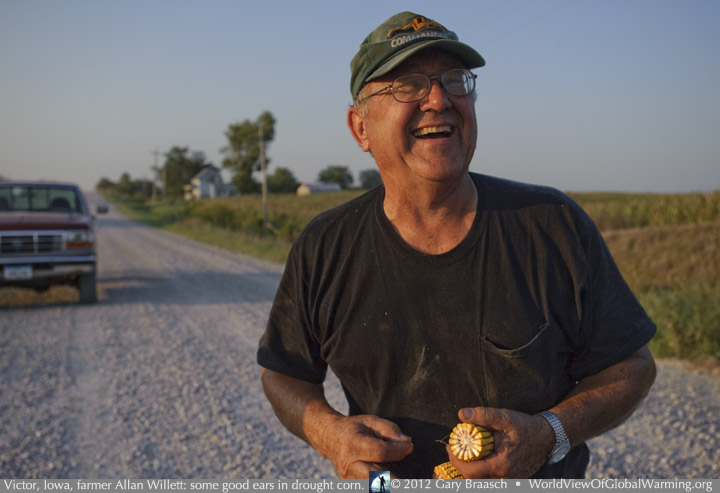
Farmer Allan Willett near Victor, Iowa, shows some fair ears of corn, which he was happy to find in a field with very heavy drought damage. He farms more than a thousand acres, some of which is being cut for silage because the corn plants were damaged by both drought and windstorms.
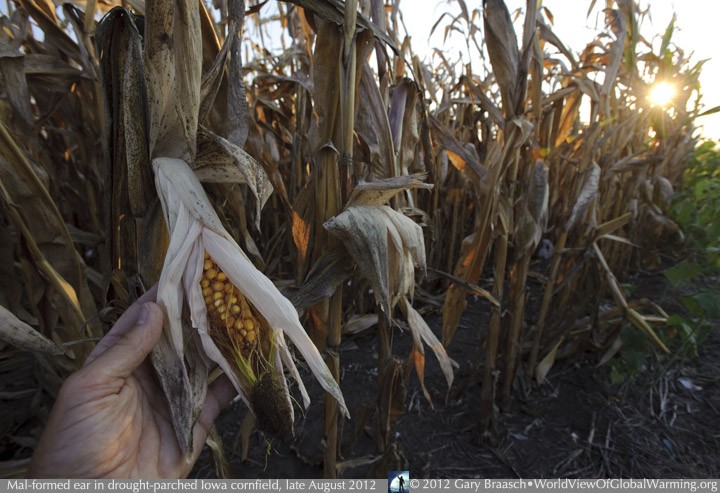
Shriveled and malformed ear of corn in a very dry field in Stuart, Iowa, commonly found in fields across the midwest hit by heat and drought since May.
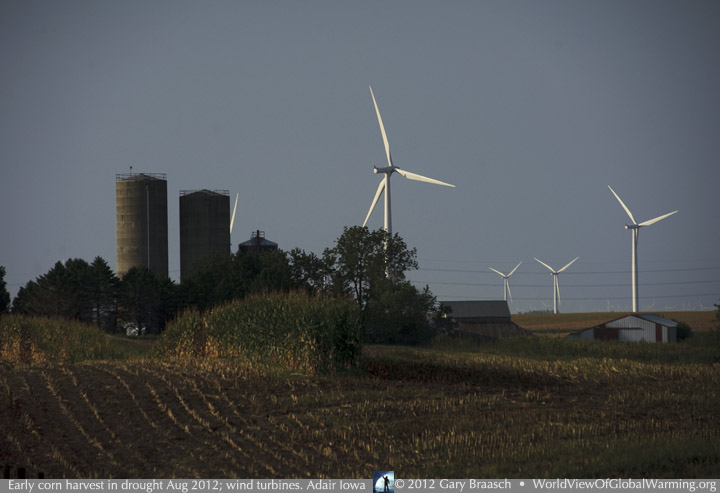
Corn fields now share the land around Adair, Iowa, with more than 400 large wind turbines -- creating a mix of fossil fueled-farming, a drought which may be exacerbated by climate change, and the new energy source which is replacing coal-fired power plants. The corn harvest here was up to two months early to salvage what could be yields only 15 percent of normal in some fields.
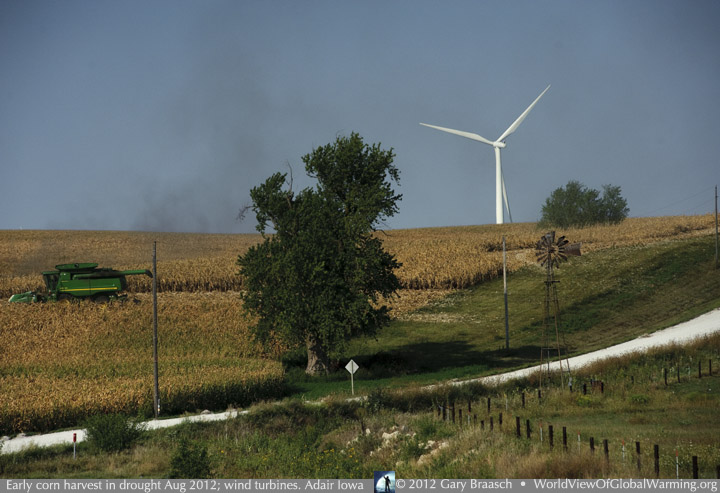
Corn fields now share the land around Adair, Iowa, with more than 400 large wind turbines -- creating a mix of fossil fueled-farming, a drought which may be exacerbated by climate change, and the new energy source which is replacing coal-fired power plants. The corn harvest here was up to two months early to salvage what could be yields only 15 percent of normal in some fields.
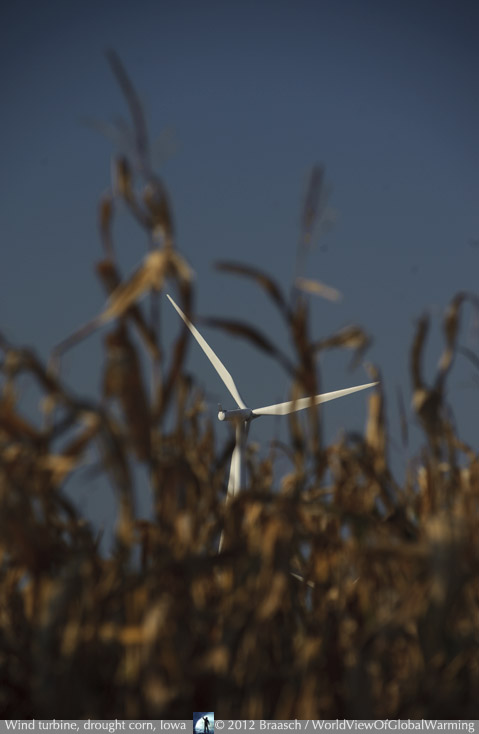
Corn fields now share the land around Adair, Iowa, with more than 400 large wind turbines -- creating a mix of fossil fueled-farming, a drought which may be exacerbated by climate change, and the new energy source which is replacing coal-fired power plants. The corn harvest here was up to two months early to salvage what could be yields only 15 percent of normal in some fields.
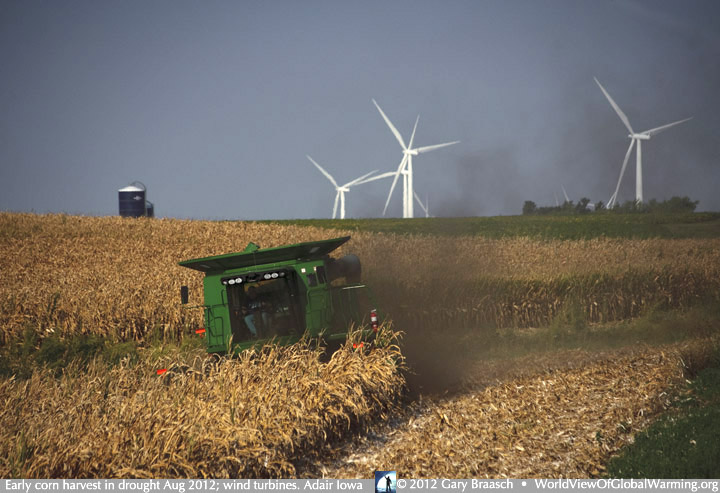
Corn fields now share the land around Adair, Iowa, with more than 400 large wind turbines -- creating a mix of fossil fueled-farming, a drought which may be exacerbated by climate change, and the new energy source which is replacing coal-fired power plants. The corn harvest here was up to two months early to salvage what could be yields only 15 percent of normal in some fields.
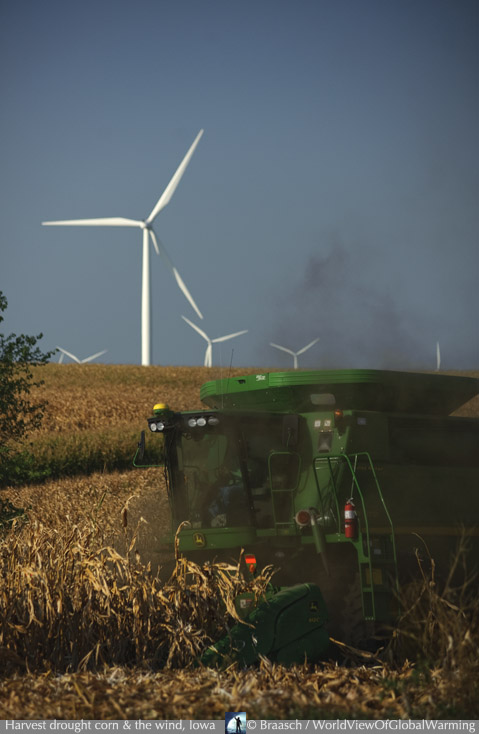
Corn fields now share the land around Adair, Iowa, with more than 400 large wind turbines -- creating a mix of fossil fueled-farming, a drought which may be exacerbated by climate change, and the new energy source which is replacing coal-fired power plants. The corn harvest here was up to two months early to salvage what could be yields only 15 percent of normal in some fields.
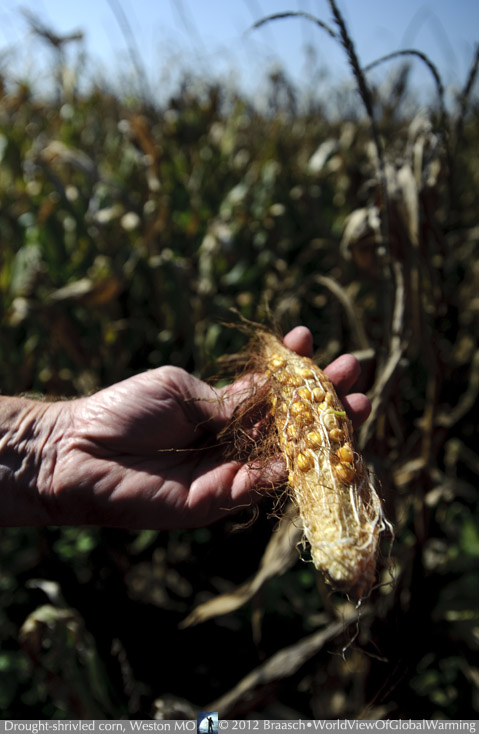
Cornfields in the bottomland along the Missiouri River, Weston, MO, owned by Rogers Strickland were heavily hit by the drought, but show a wide range of yield. "I could have 160 bushels/acre or zero," he said, scanning across some of his 1000 acres of corn in early September. The parts of his crop planted in April did well, but fields planted in May were hit by heat and drought before they could develop well. Corn planted in sandy ground in the bottomland also were burned out and yielded very little. He harvested most of the corn fields early, in mid-September, and ended up losing one third of the crop. Strickland's soybeans were also baked by the drought, with yields down 30-40 percent.
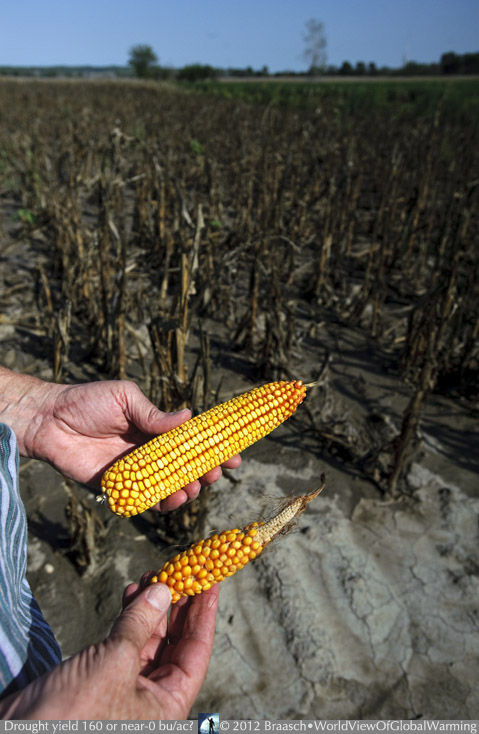
Cornfields in the bottomland along the Missiouri River, Weston, MO, owned by Rogers Strickland were heavily hit by the drought, but show a wide range of yield. "I could have 160 bushels/acre or zero," he said, scanning across some of his 1000 acres of corn in early September. The parts of his crop planted in April did well, but fields planted in May were hit by heat and drought before they could develop well. Corn planted in sandy ground in the bottomland also were burned out and yielded very little. He harvested most of the corn fields early, in mid-September, and ended up losing one third of the crop. Strickland's soybeans were also baked by the drought, with yields down 30-40 percent.
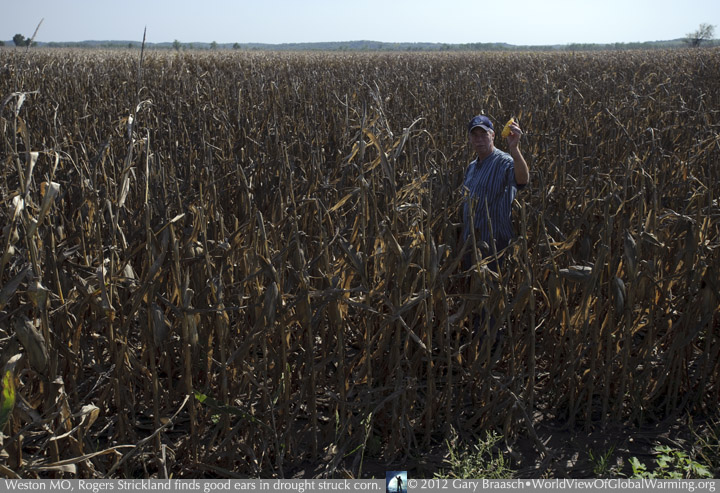
Cornfields in the bottomland along the Missiouri River, Weston, MO, owned by Rogers Strickland were heavily hit by the drought, but show a wide range of yield. "I could have 160 bushels/acre or zero," he said, scanning across some of his 1000 acres of corn in early September. The parts of his crop planted in April did well, but fields planted in May were hit by heat and drought before they could develop well. Corn planted in sandy ground in the bottomland also were burned out and yielded very little. He harvested most of the corn fields early, in mid-September, and ended up losing one third of the crop. Strickland's soybeans were also baked by the drought, with yields down 30-40 percent.
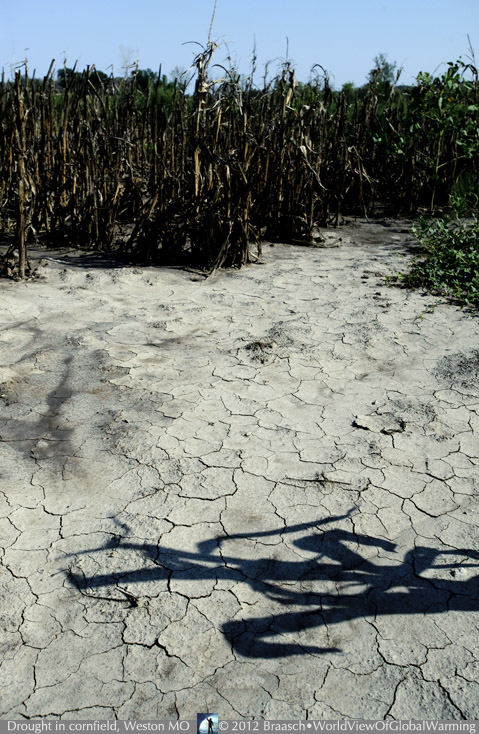
Cornfields in the bottomland along the Missiouri River, Weston, MO, owned by Rogers Strickland were heavily hit by the drought, but show a wide range of yield. "I could have 160 bushels/acre or zero," he said, scanning across some of his 1000 acres of corn in early September. The parts of his crop planted in April did well, but fields planted in May were hit by heat and drought before they could develop well. Corn planted in sandy ground in the bottomland also were burned out and yielded very little. He harvested most of the corn fields early, in mid-September, and ended up losing one third of the crop. Strickland's soybeans were also baked by the drought, with yields down 30-40 percent.
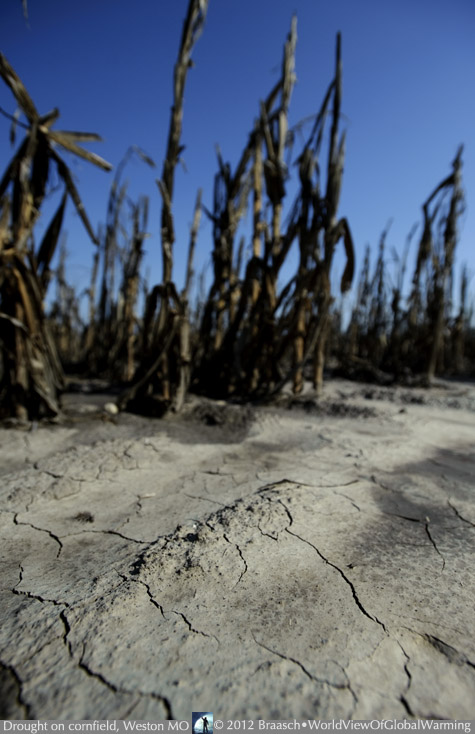
Cornfields in the bottomland along the Missiouri River, Weston, MO, owned by Rogers Strickland were heavily hit by the drought, but show a wide range of yield. "I could have 160 bushels/acre or zero," he said, scanning across some of his 1000 acres of corn in early September. The parts of his crop planted in April did well, but fields planted in May were hit by heat and drought before they could develop well. Corn planted in sandy ground in the bottomland also were burned out and yielded very little. He harvested most of the corn fields early, in mid-September, and ended up losing one third of the crop. Strickland's soybeans were also baked by the drought, with yields down 30-40 percent.
COPYRIGHT NOTICE:
Photography and text Copyright © 2005 - 2017 (and before) Gary Braasch All rights reserved. Use of photographs in any manner without permission is prohibited by US copyright law. Photography is available for license to publications and other uses. Please contact requestinformation@worldviewofglobalwarming.org. View more of Gary Braasch's photography here.


